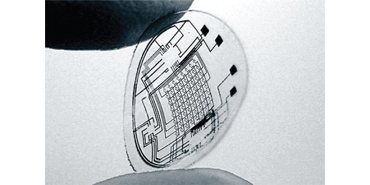Photo: University of Washington
I spotted this one from my friends at PSFK.
For a good while now, the University of Washington has been working on technology that bring the movie predictions of a bionic eye a little closer to reality. Remember in Terminator when Arnold Schwarzenegger pans around and we see data about people overlaid on his vision – the first glimpse of augmented reality perhaps? We’re getting closer and closer to that. Even back in 2009, UW was producing contacts lenses with built in electronics – including a small LED. The use cases – when this technology reaches mass market – are huge.
Heads up displays of all types could be imagined. You could walk in to a room and instantly be reminded of everyone’s name, their kids birthdays and their latest status updates on Facebook or Twitter – all without them seeing what you see. When navigating a strange city, you could be directed without ever having to look down at a map. As the ieee article notes, there are other uses such as assisting diabetic wearers keep tabs on blood-sugar levels without needing to pierce a finger. It goes much further
“an appropriately configured contact lens could monitor cholesterol, sodium, and potassium levels, to name a few potential targets. Coupled with a wireless data transmitter, the lens could relay information to medics or nurses instantly, without needles or laboratory chemistry, and with a much lower chance of mix-ups. Coupled with a wireless data transmitter, the lens could relay information to medics or nurses instantly, without needles or laboratory chemistry, and with a much lower chance of mix-ups.”
There is a long way to go of course, not least because of the toxic of current LED’s (do you want aluminum gallium arsenide in your eye?) and the heat generated by the circuitry. But the potential is huge and perhaps even a little scary. As one of the comments on the original post noted, it’s a whole new way to cheat in exams!
Me, I thought of what it’d be like to hook this up to the face recognition technology I posted about a few weeks ago.




